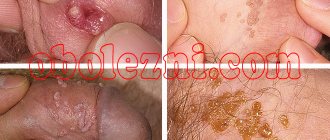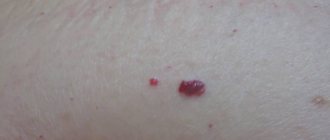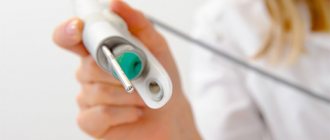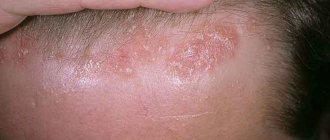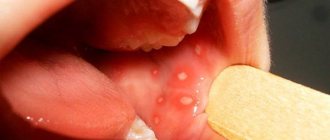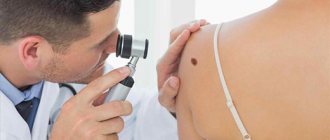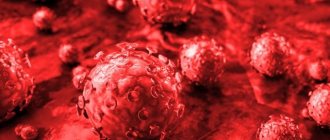What is it and how is it different from moles and papilloma?
The main difference between red formations and papilloma and moles is that they grow from the walls of blood vessels. This actually explains the color of the neoplasms.
Initially, the growth looks like a small point, which then grows and can reach various sizes. In this case, the red wart may look like a spot, or may protrude slightly above the skin surface.
Reference! Quite often, red warts form on the human body during adolescence (adolescence, period of variability, old age).
Possible complications
Bleeding from a wart is not only unpleasant. It can lead to a number of complications, sometimes very serious.
First, the bleeding itself is dangerous. If the bleeding is not stopped, there is a possibility that it will continue to flow for a long time. This can affect a person's general condition. In this case, dizziness, darkening of the eyes, and noise in the ears are observed, which ultimately leads to loss of consciousness of the victim. Possible decrease in blood pressure. But the most important complication in this situation is uncontrolled blood loss. What to do in this case? Contact your doctor immediately. And if this is not possible, call an ambulance.
Secondly, an open wound is a “wide gate” for various infections to enter. If you do not pay due attention to the problem (getting into the wound with dirty hands, using unsterile objects), there is a possibility of introducing dangerous bacteria. As a result, inflammation of the affected area occurs. This is followed by suppuration and, in some cases, tissue necrosis.
The next possible scenario is the spread of viral infection cells. A wart has infected cells that are easily spread throughout the body when the growth is injured. Thus, multiple growth of papillomas occurs throughout the skin.
What to do in case of complications, such as a blood trail? Seek help from a specialist immediately. Only an experienced doctor can make an adequate decision regarding immediate assistance.
Types of growths on the body
Similar formations can be observed in men and women, even in children; they are divided into two main types, by which benign neoplasms can be distinguished from other skin defects:
- flat – the structure is dense, outwardly reminiscent of moles;
- cavernous - rise above the surface of the skin, growing outward.
Combined elevations are also diagnosed - a combination of simple and cavernous neoplasms, as well as mixed ones - in addition to blood vessels, they include nervous and muscle tissue; such neoplasms are called hemangiomas.
According to their appearance, red warts are classified as follows:
- flat;
- branched;
- pineal;
- knotty.
It must be said that the type of red wart does not matter to the patient himself; this information is needed only by a specialist in order to determine which method of removing a skin growth will be more preferable.
Red warts are an accumulation of small blood vessels in a group; the mechanism of this association is not yet known to science, but some experts believe that this phenomenon may be caused by the influence of certain protein structures that are synthesized in utero - in the placenta.
Types of hemangiomas
It is now known that there are 4 types of skin growths:
- Ordinary;
- Flat;
- Genital warts;
- Age growths.
These are dense keratinized papules with varying diameters from 1 to 10 mm. As a rule, common warts are localized on the back of the hands. As a rule, neoplasms of this type disappear without therapy in about 2 years.
Plantar wart This is a type of simple wart. It often forms in the area where shoes rub against the skin.
At the initial stages, the neoplasm resembles a small, shiny, and then keratinized papule or yellowish-gray plaque. Usually a single wart forms, but cases with many at the same time have been reported.
Smaller growths combine into one growth and form a “mosaic” wart. Plantar growths have a rather dense surface, a gray-dirty color, and are also accompanied by aching pain that intensifies with movement.
Often, a plantar growth causes temporary disability.
Flat (juvenile wart)
The neoplasm has the shape of a papule with clear boundaries and a smooth surface. Its diameter is approximately 1-5 mm.
Based on the name, it is easy to guess that they are diagnosed in children and adolescents. Most often, neoplasms are localized on the back of the arms, legs, and sometimes in the face.
The reason for the development of a flat growth can be skin irritation due to scratches and microtraumas. A flat wart has a rounded appearance and irregular shape.
Genital wart or condyloma
Small pink nodules connecting with each other form a papillary formation with a soft consistency. Such growths form in both male and female representatives on the organs of the reproductive system.
The main route of transmission is sexual contact; existing microcracks and injuries especially increase the risk of transmission of infection. When warts are not removed, they begin to actively grow to enormous sizes and cause harm to health.
Senile wart (keratoma)
A common benign neoplasm. Typically, such warts are diagnosed in old age when the epidermis grows.
The factors behind their appearance have not been fully studied, but there is an assumption that human papillomavirus infection does not contribute to the growth of the tumor. They are usually localized in the chest, face, neck and other areas of the skin.
Such warts do not affect; mild signs indicate the beginning of the necrotic process. Therefore, if blood or other fluids appear, you should be alert and seek the advice of an experienced dermatologist.
| Types of warts | Characteristic |
| Simple | It forms on any part of the human body and affects both adults and small children. The formation has a dense structure, the diameter varies up to 5 mm, the surface is rough, lumpy, from dark to pale pink in color. |
| Flat | The formation is irregular in shape, has a smooth and even surface protruding above the skin level. It occurs more often in young children whose immunity is not yet fully developed. The formation tends to become inflamed and itchy. |
| Plantar | Formed on the soles of the feet, it has a yellowish tint, a rough, uneven surface that cracks. If the tumor is not removed in time, it grows into the deep layers of the skin, and when walking a person experiences discomfort and pain. |
| Thread-like | Formed on soft, delicate tissues (the area around the eyes, neck, armpits, groin). The formation measures no more than 1 mm and is attached to the skin thanks to a thin stalk. When damaged, it bleeds profusely and becomes inflamed. |
| Condyloma acuminata | Formed on the mucous tissues of the oral cavity, nasopharynx, and genitals. |
Main locations
Very often, red warts appear on the scalp, face, neck and chest, shoulders and back. Often these neoplasms can be seen in other places. The favorite place for such growths to occur is in areas with thin skin and nearby vessels.
Reference! Sometimes red warts also appear on internal organs - kidneys, liver, intestines.
Causes of appearance and methods of infection
As already mentioned, to date scientists have not been able to establish the exact causes of red warts.
But there are known provoking factors that can give impetus to the occurrence of this pathology:
- Mechanical damage . Bites, cuts, cracks, scratching and irritations on the skin can destroy the capillary network.
- Fast weight gain or loss . This leads to the fact that in certain places the skin is stretched and small capillaries break.
- Hormonal disorders . They can be triggered not only by diseases of internal organs and systems, but also by physiological conditions - pregnancy, menopause.
- Malfunctions of the liver and pancreas.
- Growth of a malignant tumor in the body.
Can they appear in women during pregnancy?
During pregnancy, the female body undergoes a large number of changes, they mainly relate to hormonal levels. These changes can trigger the appearance of red warts.
In addition, in a pregnant woman, the skin on the abdomen becomes very stretched and thins, therefore, small capillaries can be damaged, which is also a provoking factor in the formation of red warts.
Why do they appear in children?
In childhood, this disease may be associated with the following reasons:
- the body's reaction to hypoxia;
- genetic pathologies in the development of vascular tissue.
Since red warts consist of vascular tissue, which is filled with blood, and there is no infectious agent in them, they cannot become infected.
Why do warts appear?
In order to successfully treat and subsequently prevent the recurrence of the disease, it is necessary to understand why it occurred. The cause of viral warts is the human papillomavirus.
Many strains of the virus are completely harmless and do not manifest themselves in any way. Warts occur when the immune system is weakened due to poor diet, an infectious disease, or another virus.
You can become infected with the human papillomavirus through:
- blood. Through direct contact with damaged skin, the virus can be transmitted from wound to wound;
- mucous membranes;
- sexual contact.
Often this disease can be picked up in public places. To avoid infection, you should use only your own hygiene products, towels, and clothing.
The appearance of viral warts in children is associated with their active activity, leading to multiple skin lesions. And in conditions of contact with the virus located in ponds, sandboxes and other places, the disease is guaranteed.
Signs
Red warts do not manifest themselves symptomatically, they do not interfere physically, and the most that can bother a person is a cosmetic defect.
However, the manifestations of neoplasms may depend on the location, structure and characteristics of the course, for example:
- on the neck , can put pressure on the trachea and interfere with normal breathing;
- near the eye or ear area may limit vision or hearing.
If red warts are located on internal organs, they can interfere with their functionality; such neoplasms have a particularly negative effect in childhood – during the period of growth.
Options for the development of warts without treatment:
- an increase in the size and number of tumors;
- for a long time everything will remain unchanged;
- spontaneous disappearance.
Options for the course of pathology during treatment:
- neoplasms completely disappear at the very beginning of therapy;
- warts disappear gradually with treatment;
- warts remain resistant to treatment.
Speaking about the unpredictability of red warts, it must be said that even after complete recovery, a relapse is not excluded.
Why is their occurrence dangerous?
In the vast majority of cases, red warts are benign neoplasms, but sometimes they can lead to complications:
- Neoplasms can become inflamed - ulcers, erosions and bleeding wounds appear.
- Large neoplasms pose a greater danger, since they are more prone to injury, and due to the large accumulation of blood vessels, bleeding is quite difficult to stop.
- If the integrity of the formation is violated, a secondary infection may occur, with all the ensuing consequences.
If the wart grows rapidly and has reached a large size, it makes sense to conduct a biopsy and histological analysis to exclude an oncological process.
Diagnosis of neoplasm
Diagnosis of red warts on the body is carried out by a pediatrician, dermatologists and a surgeon; if the tumor has arisen on internal organs, you should contact a specialist.
Diagnostics consists of the following studies:
- initial examination;
- Ultrasound;
- dermatoscopy is a non-invasive procedure;
- angiography is a study of the vessels that are adjacent to the tumor; it is possible to conduct a study with a contrast liquid.
If a tumor on the skin begins to change - bleed, enlarge, change color or shape, or experience pain or discomfort, you should definitely consult a doctor.
Self-medication is strictly prohibited, since therapy in each specific case is selected individually, in accordance with age, state of immunity, neglect of the pathology, and so on.
Necessary actions for wart bleeding
When, for any reason, blood comes from a wart, this is a reason to immediately consult a doctor. But what to do before that? First, you need to stop the bleeding. I do this with the help of hydrogen peroxide, which is probably in every home medicine cabinet. It is important that before starting to treat a wound, a person disinfects his hands and the objects used. Using a cotton swab, gently wipe the bleeding wound with the solution. You can use weak solutions of Furacilin or potassium permanganate. The use of iodine or brilliant green is undesirable. However, they can be used. Just under no circumstances should you fill the wound itself with these solutions. You should use a cotton swab to treat the skin around the wound. This action will help prevent bacterial infection from entering the blood.
After disinfection, you should seal it with a special antibacterial patch or sterile bandage, which is changed as it gets wet.
If the fallen papilloma persists, it should be shown to a doctor. There is a possibility that the growth will be needed for subsequent histological examination.
If the bleeding does not stop within 10 minutes, it is unacceptable to postpone a visit to the doctor. Since stopping it, at this stage, is the main task. If, in addition to bleeding, there are symptoms of deterioration in health (dizziness, nausea, loss of consciousness), the question of calling an ambulance arises.
After the examination, the doctor will decide on the need to remove necrotic tissue, additional laboratory tests and procedures, and tell the patient what to do after the wound has healed.
Treatment
As a rule, treatment for a red wart is prescribed when it causes physical or cosmetic discomfort. In other cases, nothing needs to be done.
Drug therapy
Conservatively, red warts are treated with the following medications:
- Hormones . This is the most effective therapy, but drugs in this group are selected strictly on an individual basis after the necessary diagnosis, in addition, hormonal treatment must be monitored by the attending physician.
- Sclerosing therapy . Subcutaneous injection of ethyl alcohol is carried out. Thus, scar tissue is formed, which compresses the blood vessels. As a result, the neoplasm cells die. Despite the simplicity of this procedure, it should only be performed in a hospital setting.
Surgical removal
You can remove red warts in the following ways:
- Cryodestruction - neoplasm cells are frozen with liquid nitrogen.
- Electrocoagulation - the neoplasm is cauterized, and the vessels are simultaneously sealed. The disadvantage of this removal is that noticeable scars remain after the procedure.
- Laser coagulation is a gentle method of removal, so it can be used on children, and even remove tumors on the delicate skin near the eyes. Several procedures will be required at intervals of a week.
- Surgical excision - used in the presence of large red subcutaneous warts. Removal is carried out with a scalpel at a time. The downside is that after the procedure there is a scar or scar.
ethnoscience
Traditional medicine offers the following methods for treating red warts:
- wipe the wart with onion juice twice a day;
- apply compresses with honey, castor or linseed oil;
- take wormwood tincture;
- make a kombucha bandage.
However, it must be said that traditional medicine does not see the point in treating a red wart using traditional methods, since it is different in nature from ordinary warts, which are caused by viral agents.
Effective removal methods
Need advice from an experienced doctor?
Get a doctor's consultation online. Ask your question right now.
Ask a free question
Warts are treated with antiviral therapy, but the method is not effective against hemangiomas. If the red pigment spots do not interfere, are small in size and are not in a dangerous area subject to injury, treatment is not necessary. Removal is required in cases of a cosmetic defect, a large area of formation, or in places of increased friction. The clinic will conduct diagnostics, study the causes and nature of the red growth. The doctor decides which treatment will be effective in your case.
Taking pharmaceutical drugs
Treatment is based on taking hormonal and sclerosing drugs. Hormone therapy is effective, but not suitable for everyone. Prescribed by a doctor, medication is taken under the supervision of a specialist. Treatment with the sclerosing method involves a subcutaneous injection of ethyl alcohol in the area with the red wart. Its injection effect promotes the formation of scar tissue, which constricts the blood vessels, causing the gradual destruction of the element.
Surgical removal
You can remove warts using several methods, the effectiveness of which is justified.
| Method | Description |
| Laser therapy | Removal occurs with a laser, which excises the red formation painlessly and quickly. The laser removes warts in hard-to-reach areas, on the face and intimate areas. The procedure is suitable for children. The result is clear skin without scars or scars. |
| Cryodestruction | Getting rid of red growth by freezing cells. During the procedure, the area is treated with liquid nitrogen. A repeat procedure may be required for complete removal. |
| Diathermoelectrocoagulation | During the manipulations, a high-frequency current apparatus is used to excise the red formation and seal the vessels. A positive aspect of the method is the absence of bleeding. Applicable only in cases with external growths. |
| Radio wave | Excision of the wart occurs using a radio knife. Does not leave scars or scars. The operation is quick and painless. |
| Surgical | An effective way to get rid of unwanted growth entirely and in one go. Allows you to remove subcutaneous and large elements, minimal likelihood of relapse. Leaves a slight scar. |
Removal using traditional methods
It is not recommended to carry out removal using alternative medicine methods. With home treatment, there is a high risk of complications; a network of blood vessels is involved in the formation of the red formation.
